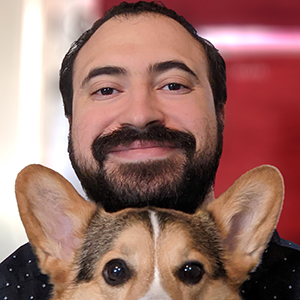Ostrander EA, Wang GD, Larson G, vonHoldt BM, Davis BW, Jagannathan V, Hitte C, Wayne RK, Zhang YP; Dog10K Consortium. Dog10K: an international sequencing effort to advance studies of canine domestication, phenotypes and health. Natl Sci Rev. 2019 Jul;6(4):810-824. doi: 10.1093/nsr/nwz049. Epub 2019 Apr 10. [PubMed]
Spatola GJ, Buckley RM, Dillon M, Dutrow EV, Betz JA, Pilot M, Parker HG, Bogdanowicz W, Thomas R, Chyzhevskyi I, Milinevsky G, Kleiman N, Breen M, Ostrander EA, Mousseau TA. The dogs of Chernobyl: Demographic insights into populations inhabiting the nuclear exclusion zone. Sci Adv. 2023 Mar 3;9(9):eade2537. doi: 10.1126/sciadv.ade2537. Epub 2023 Mar 3. [PubMed]
Dutrow EV, Serpell JA, Ostrander EA. Domestic dog lineages reveal genetic drivers of behavioral diversification. Cell. 2022 Dec 8;185(25):4737-4755.e18. doi: 10.1016/j.cell.2022.11.003. [PubMed]
Horvath S, Lu, AT, Haghani A, Zoller JA, Li CZ, Lim AR, Brooke RT, Raj K, Serres-Armero A, Dreger DL, Hogan AN, Plassais J, Ostrander EA. (2022). DNA methylation clocks for dogs and humans. Proc Natl. Acad Sci. U.S.A. 119 (21) e2120887119. doi: 10.1073/pnas.2120887119. Epub 2022 May 17. [PubMed]
Plassais J, vonHoldt BM, Parker HG, Carmagnini A, Dubos N, Papa I, Bevant K, Derrien T, Hennelly LM, Whitaker DT, Harris AC, Hogan AN, Huson JG, Zaibert VF, Linderholm A, Haile J, Fest T, Habib B, Sacks BN, Benecke N, Outram AK, Sablin MV, Germonpre M, Larson G, Frantz L, Ostrander EA. (2022). Natural and human-driven selection of a single non-coding body size variant in ancient and modern canids. Current Biol. Feb 28;32(4):889-897.e9. doi: 10.1016/j.cub.2021.12.036. Epub 2022 Jan 31. [PubMed]
Stephan T, Burgess SM, Cheng H, Danko CG, Gill CA, Jarvis ED, Koepfli K-P, Koltes JE, Lyons E, Ronald PC, Ryder OA, Schriml L, Soltis PS, VandeWoude S, Zhou H, Ostrander EA, Karlsson EK (2022). Darwinian genomics and diversity in the tree of life. Proc Natl Acad Sci U.S.A. Jan 25;119(4):e2115644119. doi: 10.1073/pnas.2115644119 [PubMed]
Sommer BC, Dhawan D, Ruple A, Ramos-Vara J, Hahn NM, Utturkar SM, Ostrander EA, Parker HG, Fulkerson CM, Childress MO, Fourez LM, Enstrom AW, Knapp DW. (2021). Basal and luminal molecular subtypes in naturally-occurring canine urothelial carcinoma are associated with tumor immune signatures and dog breed. Bladder Cancer 7(3): 317-333. DOI: 10.3233/BLC-201523. [Full Text]
Evans JM, Parker HG, Rutteman GR, Plassais J, Grinwis GCM, Harris AC, Lana SE, Ostrander EA. (2021). Multi-omics approach identifies germline regulatory variants associated with hematopoietic malignancies in retriever dog breeds. PLOS Genet. 17(5): e1009543. doi: 10.1101/2021.04.05.438235 [PubMed]
Surbakti S, Parker HG, McIntyre JK, Maury HK, Cairns KM, Selvig M, Pangau-Adam M, Safonpo A, Numberi L, Runtuboi DYP, Davis BW, Ostrander EA. (2020). New Guinea highland wild dogs are the original New Guinea Singing dogs. Proc Natl Acad Sci U S A. Sep 29;117(39):24369-24376. doi:10.1073/pnas.2007242117. 2020. [PubMed]
Wang T, Ma J, Hogan AN, Fong S, Licon K, Tsui B, Kreisberg JF, Adams PD, Carvunis AR, Bannasch DL, Ostrander EA, Ideker T. (2020) Quantitative translation of dog-to-human aging by conserved remodeling of the DNA methylome. Cell Syst. Aug 26;11(2):176-185.e6. doi:10.1016/j.cels.2020.06.006. 2020. [PubMed]
Serres-Armero A., Davis BW, Povolotskaya IS, Morcillo-Surarez C, Plassais J, Juan D, Ostrander EA*, Marques-Bonet T*. (2020). Copy number variation underlies complex phenotypes in domestic dog breeds and other canids. Genome Res Apr 16. doi: 10.1101/gr.266049.120. *Co-Senior authors [PMC8092016]
Ostrander EA, Wang G-D, Larson G, vonHoldt BM, Davis BW, Jagannathan V, Hitte C, Wayne RK, Zhang, Y-P, Dog10K Consortium. Dog10K: an international sequencing effort to advance studies of canine domestication, phenotypes, and health. Natl Sci Rev. Jul;6(4):810-824. doi:10.1093/nsr/nwz049. 2019. [PubMed]
Plassais J, Kim J, Davis BW, Karyadi DM, Hogan AN, Harris AC, Decker B, Parker HG, Ostrander EA. Whole genome sequencing of canids reveals genomic regions under selection and variants influencing morphology. Nat Comm. Apr 2;10(1):1489. doi:10.1038/s41467-019-09373-w. 2019. [PubMed]
Kim J, Williams FJ, Dreger DL, Plassais J, Davis BW, Parker HG, Ostrander EA. Genetic selection of athletic success in sport hunting dogs. Proc Natl Acad Sci U S A. Jul 24;115(30):E7212-E7221. doi:10.1073/pnas.1800455115. 2018. [PubMed]
vonHoldt BM, Shuldiner E, Janowitz-Koch I, Kartzinel RY, Hogan A, Brubaker L, Wanser S, Stahler D, Wynne CDL, Ostrander EA, Sinsheimer JS, Udell MAR. Structural variants in genes associated with human Williams-Beuren syndrome underlie stereotypical hypersociability in domestic dogs. Sci Advances. Jul 19;3(7):e1700398. doi:10.1126/sciadv.1700398. 2017. [PubMed]
Parker HG, Dreger DL, Rimbault M, Davis BW, Mullen AM, Carpintero-Ramirez G, Ostrander EA.. Genomic analysis reveals the influence of geographic origin, immigration and cross-breed introgression on modern dog breed development. Cell Reports. Apr 25;19(4):697-708. doi:10.1016/j.celrep.2017.03.079. 2017. [PubMed]
Decker B, Karyadi DM, Davis BW, Karlins E, Tillmans LS, Stanford JL, Thibodeau SN, Ostrander EA.Biallelic BRCA mutations shape the somatic mutational landscape of aggressive prostate tumors. Am J Hum Genet. May 5;98(5):818-829. doi:10.1016/j.ajhg.2016.03.003. 2016. [PubMed]
Decker B, Davis BW, Rimbault M, Long AH, Karlins E, Jagannathan V, Reiman R, Parker HG, Drögemüller C, Corneveaux JJ, Chapman ES, Trent JM, Leeb T, Huentelman JM, Wayne RK, Karyadi DM, Ostrander EA. Comparison against 186 canid whole-genome sequences reveals survival strategies of an ancient clonally transmissible canine tumor. Genome Res. Nov;25(11):1646-55. doi:10.1101/gr,190314.115. 2015. [PubMed]
Decker B, Parker HG, Dhawan D, Kwon EM, Karlins E, Davis BW, Ramos-Vara JA, Bonney PL, McNiel EA, Knapp DW, Ostrander EA. Homologous mutation to human BRAF V600E is common in naturally occurring canine bladder cancer-evidence for a relevant model system and urine-based diagnostic test. Mol Canc Res. Jun;13(6):993-1002. doi:10.1158/1541-7786.MCR-14-0689. 2015. [PubMed]
Parker HG, Ostrander EA. Cancer. Hiding in plain view: An ancient dog in the modern world. Science. Jan 24;343(6169):376-8. doi:10.1126/science.1248812. 2014. [PubMed]
Karyadi DM, Karlins E, Decker B, vonHoldt BM, Carpintero-Ramirez G, Parker HG, Wayne RK, Ostrander EA. A copy number variant at the KITLG locus likely confers risk for canine squamous cell carcinoma of the digit. PLoSGenetics. Mar;9(3):e1003409. doi:10.1371/journal.pgen.1003409. 2013. [PubMed]
Boyko AR, Quignon P, Li L, Schoenebeck JJ, Degenhardt JD, Lohmueller KE, Zhao K, Brisbin A, Parker HG, vonHoldt BM, Cargill M, Auton A, Reynolds A, Elkahloun AG, Castelhano M, Mosher DS, Sutter NB, Johnson GS, Novembre J, Hubisz MJ, Siepel A, Wayne RK, Bustamante CD, Ostrander EA. A simple genetic architecture underlies morphologic variation in dogs. PLoS Biol. Aug 10;8(8):e1000451. doi:10.1371/journal.pgen.1000451. 2010. [PubMed]
vonHoldt BM, Pollinger JP, Lohmueller KE, Han E, Parker HG, Quignon P, Degenhardt JD, Boyko AR, Earl DA, Auton A, Reynolds A, Bryc K, Brisbin A, Knowles JC, Mosher DS, Spady TC, Elkahloun A, Geffen E, Pilot M, Jedrzejewski W, Greco C, Randi E, Bannasch D, Wilton A, Shearman J, Musiani M, Cargill M, Jones PG, Qian Z, Huang W, Ding ZL, Zhang YP, Bustamante CD, Ostrander EA, Novembre J, Wayne RK. Genome-wide SNP and haplotype analyses reveal a rich history underlying dog domestication. Nature. Apr 8;464(7290):898-902. doi:10.1038/nature08837. 2010. [PubMed]
Cadieu E, Neff MW, Quignon P, Walsh K, Chase K, Parker HG, vonHoldt BM, Rhue A, Boyko A, Byers A, Wong A, Mosher DS, Elkahloun AG, Spady TC, André C, Lark KG, Cargill M, Bustamante CD, Wayne RK, Ostrander EA. Coat variation in the domestic dog is governed by variants in three genes. Science. Oct 2;326(5949):150-3. doi:10.1126/science.1177808. 2009. [PubMed]
Parker HG, vonHoldt BM, Quignon P, Margulies EH, Shao S, Mosher DS, Spady TC, Elkahloun A, Cargill M, Jones PG, Maslen CL, Acland GM, Sutter NB, Kuroki K, Bustamante CD, Wayne RK, Ostrander EA. An expressed Fgf4 retrogene is associated with breed-defining chondrodysplasia in domestic dogs. Science. Aug 21;325(5943):995-8. doi:10.1126/science.1173275. 2009. [PubMed]
Mosher DS, Quignon P, Bustamante CD, Sutter NB, Mellersh CS, Parker HG, Ostrander EA. A mutation in the myostatin gene increases muscle mass and enhances racing performance in heterozygote dogs. PLoS Genet. May 25;3(5):e79. doi:10.1371/journal.pgen.0030079. 2007. [PubMed]
Sutter NB, Bustamante CD, Chase K, Gray MM, Zhao K, Zhu L, Padhukasahasram B, Karlins E, Davis S, Jones PG, Quignon P, Johnson GS, Parker HG, Fretwell N, Mosher DS, Lawler DF, Satyaraj E, Nordborg M, Lark KG, Wayne RK, Ostrander EA. A single IGF1 Allele is a major determinant of small size in dogs. Science. Apr 6;316(5821):112-5. doi:10.1126/science.1137045. 2007. [PubMed]
Agalliu I, Kwon EM, Zadory D, McIntosh L, Thompson J, Stanford JL, Ostrander EA. Germline mutations in the BRCA2 gene and susceptibility to hereditary prostate cancer. Clin Cancer Res. Feb 1;13(3):839-43. doi:10.1158/1078-0432.CCR-06-2164. 2007. [PubMed]
Sutter NB, Eberle MA, Parker HG, Pullar BJ, Kirkness EF, Kruglyak L, Ostrander EA. Extensive and breed specific linkage disequilibrium in Canis familiaris. Genome Res. Dec;14(12):2388-96. doi:10.1101/gr.3147604. 2004. [PubMed]
Parker HG, Kim LV, Sutter NB, Carlson S, Lorentzen TD, Malek TB, Johnson GS, DeFrance HB, Ostrander EA, Kruglyak L. Genetic structure of the purebred domestic dog. Science. May 21;304(5674):1160-4. doi:10.1126/science.1097406. 2004. [PubMed]
Lingaas F, Comstock KE, Kirkness EF, Sørensen A, Aarskaug T, Hitte C, Nickerson ML, Moe L, Schmidt LS, Thomas R, Breen M, Galibert F, Zbar B, Ostrander EA. A mutation in the canine BHD gene is associated with hereditary multifocal renal cystadenocarcinoma and nodular dermatofibrosis in the German Shepherd Dog. Hum Mol Genet. Dec 1;12(23):3043-53. doi:10.1093/hmg/ddg336. 2003. [PubMed]
Guyon R, Lorentzen TD, Hitte C, Kim L, Cadieu E, Parker HG, Quignon P, Lowe JK, Renier C, Gelfenbeyn B, Vignaux F, DeFrance HB, Gloux S, Mahairas GG, André C, Galibert F, Ostrander EA. A 1-Mb resolution radiation hybrid map of the canine genome. Proc Natl Acad Sci U S A. Apr 29;100(9):5296-301. doi:10.1073/pnas.0831002100. 2003. [PubMed]
Jónasdóttir TJ, Mellersh CS, Moe L, Heggebø R, Gamlem H, Ostrander EA, Lingaas F. Genetic mapping of a naturally occurring hereditary renal cancer syndrome in dogs. Proc Natl Acad Sci U S A. Apr 11;97(8):4132-7. doi:10.1073/pnas.070053397. 2000. [PubMed]
Malone KE, Daling JR, Thompson JD, O'Brien CA, Francisco LV, Ostrander EA. BRCA1 mutations and breast cancer in the general population: Analyses in women before age 35 years and in women before age 45 years with first-degree family history. J Am Med Assoc. Mar 25;279(12):922-9. doi:10.1001/jama.279.12.922. 1998. [PubMed]
Mellersh CS, Langston AA, Acland GM, Fleming MA, Ray K, Wiegand NA, Francisco LV, Gibbs M, Aguirre GD, Ostrander EA. A linkage map of the canine genome. Genomics. Dec 15;46(3):326-36. doi:10.1006/geno.1997.5098. 1997. [PubMed]
Langston AA, Malone KE, Thompson JD, Daling JR, Ostrander EA. BRCA1 mutations in a population-based sample of young women with breast cancer. N Engl J Med. Jan 18;334(3):137-42. doi:10.1056/NEJM199601183340301. 1996. [PubMed]














